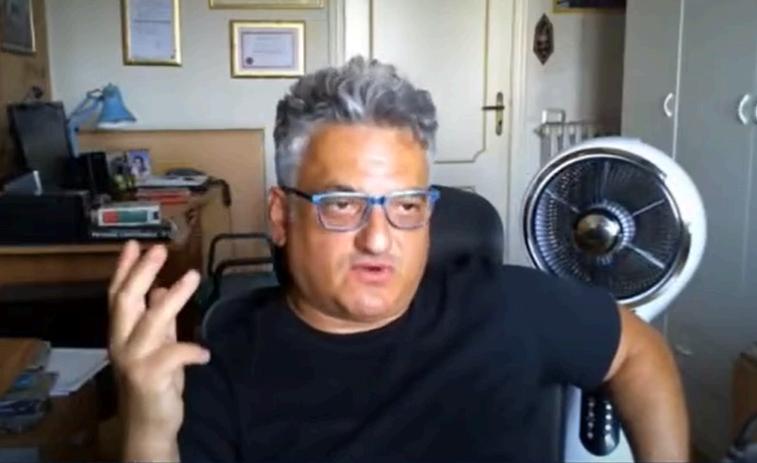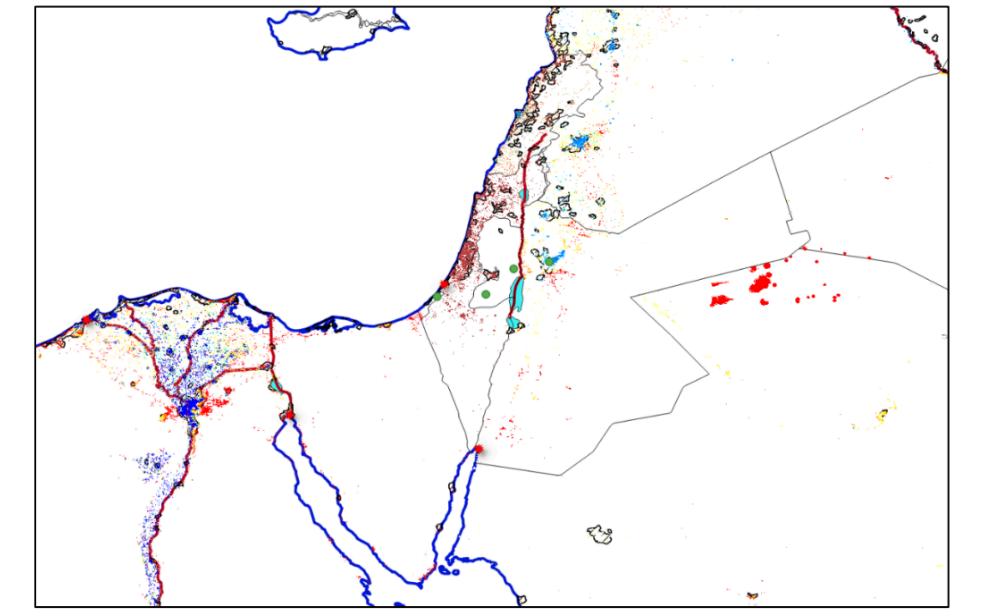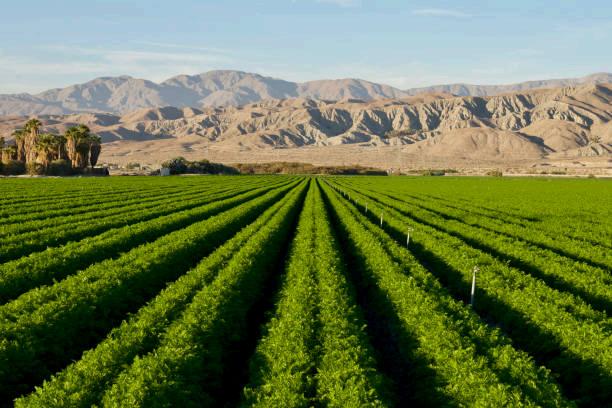Link: https://www.youtube.com/live/AhQUYD4H-IQ?feature=shared
Please see the link above for the source text.
Video Interview: Nuclear Power Can Green the Deserts of Palestine and Israel - The Oasis Plan
The Role of Advanced Nuclear Technology in the Oasis Plan
July 25, 2025


Excerpt from “The Role of Advanced Nuclear Technology in the Oasis Plan” by
Dr. Vincenzo Romanello, February
2025
2. The Need for Nuclear Energy in the Oasis Plan
The Middle East faces significant challenges in securing potable water and stable energy supplies, which are essential for long-term economic growth and social stability. Nuclear energy can play a critical role in addressing these issues through:
▪ Desalination support: nuclear reactors can provide both electricity and process heat for high-efficiency desalination technologies, such as Reverse Osmosis (RO) and Electro-Deionization (EDI), ensuring a steady water supply for human consumption and agriculture;
▪ Energy reliability: unlike intermittent renewables, nuclear power provides a stable baseload supply, reducing reliance on fossil fuels and mitigating geopolitical risks associated with energy imports;
▪ Economic development: the establishment of nuclear infrastructure fosters technological advancement, creates high-skilled jobs, and stimulates industrial growth

2.1 Water Demand and Availability for the Oasis Plan: an Overview
The Middle East and North Africa (MENA) region’s acute water scarcity stems from a confluence of rising demand, historically limited freshwater resources, and uneven distribution of what few supplies exist. In this context, the Oasis Plan envisions advanced nuclear-powered desalination systems as a strategic means to alleviate chronic shortages. Estimating the scale of water requirements and matching them with reliable production targets is pivotal to designing an effective plan.
Current water use in MENA averages roughly 300 billion cubic meters (bcm) per year, with agriculture accounting for about 70–80% of withdrawals, followed by industrial and domestic sectors. Due to continued population growth, urbanization, and economic development, total demand could climb to 400–450 bcm/year by 2050 according to World Bank. However, the region’s natural renewable water resources estimated at 500–600 bcm/year (FAO AQUASTAT, 2023)—are not fully exploitable because of their uneven distribution (e.g., the Nile in Egypt, Tigris-Euphrates in Iraq, and minimal surface water in the Gulf states). Most critically, multiple countries, including Saudi Arabia, the United Arab Emirates (UAE), and Jordan, are already overexploiting aquifers or relying heavily on energy-intensive desalination to meet basic needs. To address these shortfalls, the Oasis Plan focuses on deploying advanced desalination facilities in coastal areas (Fig.1), powered by nuclear reactors capable of supplying both electricity and the thermal energy required for desalination. While detailed design considerations for these reactors fall under other sections of the report, reliable estimates of the necessary water supply can be derived by examining key areas of scarcity:
1. Human Consumption and Municipal Needs:
o In extremely water-stressed nations (e.g., Jordan, Yemen), current per-capita availability is below 500 m3/person/year, well under the
“absolute scarcity” threshold. By 2050, population growth alone could push these deficits even higher unless new water sources are secured;
2. Industrial Requirements:
o Rapidly industrializing economies (e.g., Saudi Arabia, UAE) have growing water demands for petrochemical and manufacturing sectors. These industries often require high-quality process water, further increasing reliance on desalination;
3. Agricultural Irrigation:
o Irrigated agriculture in MENA consumes the majority of available freshwater. In countries such as Egypt and Saudi Arabia, balancing food security aspirations with limited groundwater supplies will necessitate large volumes of alternative water particularly if they aim to maintain or expand current agricultural outputs.
Although each country’s strategy may vary, the region’s cumulative shortfall could exceed 150–200 bcm/year by 2050 if no additional interventions occur. Bridging even half of this deficit sustainably requires a massive increase in desalination capacity. Under the Oasis Plan, advanced nuclear reactors (including small modular reactors) are expected to provide steady baseload power for large-scale desalination. Today, a typical 1.4 GW nuclear power plant dedicated to desalination can generate on the order of 5.5 bcm/year of fresh water (depending on technology and operational specifics). Future reactor designs, especially those that integrate high-temperature thermal desalination, may achieve even higher outputs.
Table 1 - A snapshot of projected water deficits (the gap between demand and accessible renewable supplies) for selected countries by 2050, illustrating the scale of the challenge

In summary, population expansion and industrial development are set to push MENA’s annual demand to as high as 450 bcm by 2050, leaving many countries dependent on new water sources. Advanced desalination powered by nuclear energy can realistically provide a large fraction of this shortfall, and the Oasis Plan’s target of 100 bcm/year is designed to meet critical human, industrial, and agricultural needs across the most water-scarce areas of the region (Table 1). This sizable capacity increment, if realized, will be a cornerstone of alleviating MENA’s chronic water scarcity and securing a more stable future for millions of its inhabitants.
2.2 Nuclear Power Requirements for the Oasis Plan
The Oasis Plan calls for producing 100 billion cubic meters (bcm) of freshwater each year via large-scale reverse osmosis(RO) desalination and delivering it to interior regions across the Middle East and North Africa (MENA). Achieving this objective requires a secure and sufficiently large source of electricity. Advanced nuclear power, in the form of both large reactors (e.g., APR-1400) and smaller Generation IV Micro Modular Reactors (e.g., MMRs), provides a viable path to meeting the plan’s ambitious energy requirements.
2.2.1 Energy Demand for Desalination and Transport Modern RO systems can operate at an energy intensity of 2 kWh per cubic meter. Producing 100 bcm of desalinated water per year therefore requires about 200 TWh of electricity (i.e., 200 billion kWh). Moving this water inland—through pumping stations and pipelines adds an estimated 60 TWh annually, leading to a total power requirement of 260 TWh/year.
2.2.2 Reactor Output and Availability
Each 1400 MWe reactor, running at a 90% capacity factor, generates roughly 11 TWh of electricity per year. To supply 260 TWh (with a small buffer), 25 reactors are needed: 19 dedicated to meet the desalination demand (200 TWh) and 6 for water pumping (60 TWh) – Tab.2.
Table 2 - Base Scenario Requirements and Reactors

2.2.3 Capital Costs and Construction Time
An APR-1400 reactor costs about $5 billion, so deploying 25 units represents an investment of approximately $125 billion. Construction spans 7–10 years per reactor, although projects can be staggered or partially overlapped to optimize timelines and financing. The schedule depends on regulatory approvals, site development, and workforce availability.
2.2.4 Potential Expansion with Additional 1400 MWe Reactors
In the event that water or electricity demand exceeds current forecasts due to population growth, economic development, or a desire to further strengthen food security an additional 3–5 1400 MWe reactors may be warranted. Each new reactor adds roughly 11 TWh/year (allowing for 5–6 bcm of extra desalination capacity if used exclusively for RO or additional power for industries and residences).
▪ Cost Increase: $15–25 billion more for 3–5 reactors (at $5 billion each).
▪ Another 7–10 years for licensing, construction, and commissioning, unless integrated into earlier project phases to reduce lead time.
2.2.5 Integration of Generation IV Micro Modular Reactors (MMRs)
While APR-1400 (or any other similar) reactor excels at supplying large coastal plants with substantial baseload power, smaller Gen IV MMRs (developed in the USA by the Ultra Safe Nuclear company) complement them by serving regions with limited or unreliable grid infrastructure. These advanced reactors typically yield 5–50 MWe of electrical output (plus valuable process or district heat), making them well-suited for remote or decentralized applications.
The Micro-Modular Reactor (MMR) sets a new standard in safety and resilience by utilizing low power density and a high surface area-to-power ratio, ensuring passive heat dissipation without risk of self-damage. It employs the highest-performance TRISO fuel, fully containing fission products and eliminating contamination risks. Unlike traditional reactors, the MMR minimizes hazards, reducing the impact of any pressure release. It uses helium coolant, which poses no chemical reactivity risks and remains clean of fission byproducts. The standard 2-unit MMR system has a compact footprint (<5 acres) and employs low-impact construction, with modular, transportable components. No water outflows, no on-site spent fuel storage, and a temporary installation model make it a flexible and environmentally responsible energy solution.
Designed for unprecedented safety, the MMR can withstand natural disasters, operator errors, and sabotage scenarios without catastrophic consequences. Even events classified as beyond-design-basis accidents for conventional reactors are non-critical for the MMR. With a 50-month deployment timeline, licensing in Canada and the U.S., and ongoing demonstration projects, the MMR is positioned for global deployment. Over 20 years of operation, an MMR unit generates just 2 metric tons of
solid, confined spent fuel, which can be securely stored or reprocessed for additional energy extraction. Encapsulated in fully ceramic microstructures, spent fuel remains isolated and non-dispersive until its radioactivity naturally declines to background levels over time.
NOTE: John Shanahan, Civil Engineer, Host of website: allaboutenergy.net
The Lyndon LaRouche Organization and Schiller Institute have contributed many good plans for peace, prosperity, and a better world. The Oasis Plan, as presented by Diane Sare, and the technical realization, as outlined by nuclear engineer, Dr. Vincenzo Romanello, could be a real deal for the region of Palestine, Israel, the Middle East, and Sub-Saharan Africa.
Jordan has an excellent technical university for solving these challenges, the Jordan University of Science and Technology, JUST, in Irbid.
Water, electricity, goodwill, and brotherhood are the keys.

Let the deserts of the world turn green with crops for half a billion people. Solar photovoltaic and nuclear power could combine for cheap electricity.
